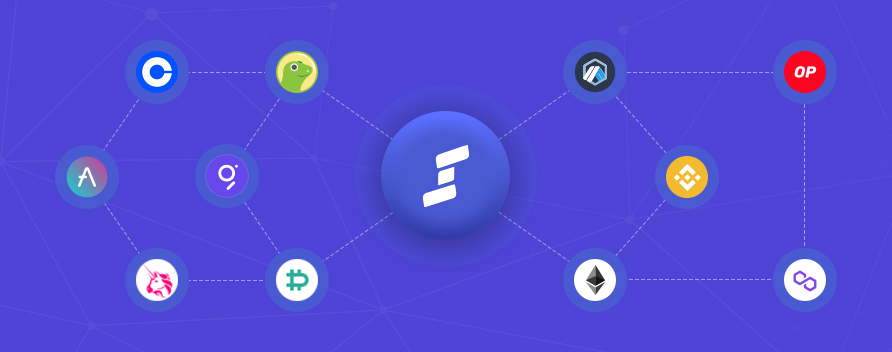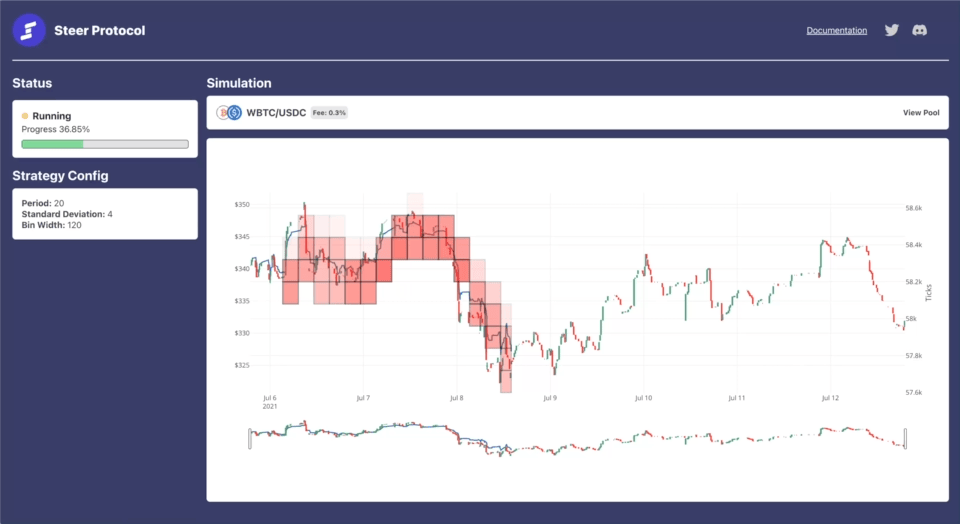Limitations of Current Automated Liquidity Providers
While automated liquidity providers have become increasingly popular in the DeFi space, they still have several limitations. One major limitation is that most providers only support 1 or 2 positions, which can lead to inefficient liquidity placement. This can have a dramatic effect on APYs but also on the total impermanent and realized losses a vault may incur during its management.
Users are also unable to deploy their own strategies and are limited to working with existing providers, whose strategies may not be optimal for their needs. This is where Steer Protocol stands out, as it allows anyone to create and deploy their own liquidity management strategies, leading to greater competition and potentially higher returns, and less risk for LPs (Liquidity Providers).
Another limitation of current automated liquidity providers is the lack of backtesting capabilities. It is important for strategists to be able to test their strategies against a market to understand the long-term effects on a pool’s capital efficiency. Without this ability, it is difficult to gauge the effectiveness of a strategy. Steer Protocol addresses this issue by providing an SDK (Software Development Kit) that allows strategists to build and test their algorithms against different timeframes and visualize the liquidity depths and overall performance statistics.
Finally, incentivizing vaults can be a challenging or even impossible task for some protocols. Incentivizing vaults is an important way to attract LPs and ensure the stability of a pool. Steer Protocol aims to make this process easy and open, allowing anyone to create and incentivize their own vaults with a click of a button.
Introduction to Steer Protocol
Steer Protocol is a decentralized off-chain compute protocol that enables developers to build yield-based strategies and applications using common programming languages such as TypeScript (AssemblyScript), Rust, Go, and many others. Steer Protocol also provides audited App Engines that can be used to enhance the developer experience when interacting with certain protocols. One of the first app engines is the concentrated liquidity engine, which allows users to manage multi-positions for a given pool and place liquidity on any capital allocation curve on CLAMM. This can lead to higher returns for liquidity providers and the ability to build more complex algorithms that reduce the risks of IL/RL during active management.
Accessing data in Web3 can be burdensome. Have you ever noticed how every API is different? In addition to the liquidity engine, Steer Protocol also offers a data marketplace that provides access to both on-chain and off-chain data. Each developer on the Steer Protocol will benefit from the open data marketplace. Enabling single-line access so developers can focus on what matters, their core logic. Can’t find the data your looking for? Developers can also build new connectors using their preferred programming language and integrate them quickly into their workflow.
Not a developer? No problem. All applications and yield strategies are built to be reused. Users on the platform benefit from the single-click forking of applications. Easily deploy your own version of an application or strategy. Applications can range from yield to operational tasks such as token distributions, oracles, and cleaning up token approvals. The possibilities are endless and the barrier to entry hasn’t been lower.
Whether you are a developer looking to build on the blockchain or an investor seeking yield-based strategies, Steer Protocol has something to offer. With its focused liquidity engine, off-chain compute, and data marketplace, it provides a powerful toolset for building and managing decentralized applications and strategies. Whether you want to build a liquidity management algorithm or automate your smart contracts based on off-chain data, Steer Protocol has the resources you need.
Introducing the Concentrated Liquidity Engine
Steer Protocol is excited to announce the launch of our first flagship App Engine, the Concentrated Liquidity Engine. This is the first-ever system to support multi-position strategies on Uniswap V3, and it provides a revolutionary new way to manage liquidity on decentralized exchanges.
With the concentrated liquidity engine, users can manage multiple positions in a given CLAMM (Uniswap) pool, allowing for greater flexibility in liquidity management. Positions can be made dynamically to fulfill any liquidity requirements, using a variety of strategies such as replicating CEX order book depths, straddling price levels, and even volatility-adjusted volume profiles. This flexibility enables users to build complex algorithms that can maximize returns and reduce risks.
The Benefits of Multi-Position Liquidity Strategies
One of the key benefits of the concentrated liquidity engine is its ability to support multi-position strategies. This is a significant improvement over traditional automated liquidity providers, which typically only support one or two positions.
By allowing users to manage multiple positions, the concentrated liquidity engine enables greater efficiency in liquidity management. It allows users to place liquidity on any capital allocation curve, enabling them to build algorithms that can adapt to changing market conditions. For stable pairs, it can be used along with normalized curves to provide optimal rewards. This means that users can maximize returns and minimize risks, leading to greater profits for liquidity providers.
The ability to build complex algorithms using multi-position strategies opens up new opportunities for users to customize their liquidity management strategies. Whether they are looking to implement trailing stops, straddling liquidity, or other advanced techniques, the concentrated liquidity engine provides the tools they need to succeed.
Secure and Easy to Use
The concentrated liquidity engine is secure and easy to use. It is designed to be accessible to all users, regardless of their technical expertise. This means that even those who are new to decentralized exchanges and liquidity management can easily take advantage of the benefits of the concentrated liquidity engine.
Additionally, the concentrated liquidity engine includes built-in security measures such as maximum slippage limits and TVL limits which can be set while deploying a strategy. These measures help to ensure the safety and security of user assets, giving users peace of mind as they manage their liquidity.
Using No-Code to Dismantle Walled Gardens
One of the main limitations of current automated liquidity platforms is the lack of self-managed liquidity management. These platforms often require users to work with existing providers and are limited in their ability to deploy their own strategies. Steer Protocol aims to change this paradigm by providing a platform that allows anyone to build and deploy their own liquidity strategies.
The Steer Protocol also offers a no-code option for web3 protocols to easily provision automated liquidity. Protocols can benefit from the simplicity of single-click onboarding, while those who want more control can use the Integrated Liquidity Development Platform from the Steer Protocol SDK to build their own strategies!
In addition to building and deploying their own strategies, users can also “fork” successful strategies for use with other assets/pairs. This feature allows users to apply proven strategies to their own assets, and simplify the technical requirements required to get started. Additionally, users can backtest their forked strategies directly in the browser(!) prior to deployment to ensure that they will perform as expected.
One of the unique features of Steer Protocol is the option to incentivize vaults. This is a great option for web3 protocols or communities that want to create incentivized vaults to bootstrap liquidity for their tokens. This can be particularly useful when creating new pools and liquidity needs to be created. The ability to self-manage liquidity management and incentivize vaults allows Steer Protocol to dismantle the current “walled gardens” of automated liquidity platforms and create a more open and competitive environment.
Integrated Liquidity Development Platform
Steer Protocol’s Integrated Liquidity Development Platform is a full-featured SDK that allows developers to build and test their liquidity strategies. Built into the core of the Steer Protocol SDK, the platform is built on WASM (WebAssembly), which means developers can use a variety of languages such as TypeScript (AssemblyScript), Rust, Go, and many others to build their strategies.
One of the unique features of the Steer Protocol SDK is the ability to backtest strategies against mainnet data. This is important because most liquidity estimators can be very inaccurate due to the fact that they only can estimate static positions that are not actively managed. Mainnet backtesting is a very valuable tool for developers, as it allows them to understand the effects of rebalances on realized losses during rebalancing. The backtesting tool can be run against any pool on Uniswap V3. For the first time, anyone will be able to backtest liquidity strategies from the comfort of their own device.
In addition to backtesting, the Steer Protocol SDK also allows developers to visualize the strategy’s liquidity levels during each rebalance. This helps developers to understand the performance of their strategies in real-time, and make any necessary adjustments. This is another first for the industry as it allows developers clear access to how their liquidity is positioned and their specific depths at different levels.
After each backtest, developers can view a performance report which provides detailed information about the performance of their strategy. This report includes metrics such as capital efficiency, returns, and more.
The Steer Protocol SDK is a powerful tool that allows developers to build and test their liquidity strategies with confidence, and understand the performance of their strategies.
The Data Connector Marketplace
Steer Protocol’s data connector marketplace is a valuable resource for developers looking to build off-chain logic for on-chain execution or yield-based strategies. It offers access to a wide range of data connectors, including Uniswap, SushiSwap, Aave, Synthetix, and Crypto Fear & Greed Index, as well as others. These connectors allow developers to quickly get started with their projects, as they can choose an off-the-shelf connector and focus only on writing the logic for their application.
In addition to these pre-existing connectors, Steer Protocol also offers integration with TheGraph APIs. This allows developers to utilize TheGraph’s powerful data indexing and querying capabilities in their projects. Steer has even provided a template to help developers get started with using TheGraph APIs which can be found, here.
But the benefits of the data connector marketplace don’t stop there. Any developer can create their own data connector for any data source, and once it is created, it can be used by all other developers on the platform. This means that the data connector marketplace is constantly growing and evolving, providing more and more options for developers.
Using multiple data sources can also increase the efficiency and reduce the risk of active management strategies. By gathering data from a variety of sources, developers can create more robust and reliable strategies that are better able to adapt to changing market conditions.
Overall, the data connector marketplace is a key feature of Steer Protocol, providing developers with access to a wide range of data sources and tools to help them build off-chain logic for on-chain execution. Whether you are a seasoned developer or just starting out, the data connector marketplace has something to offer you.

Conclusion
As a web3 enthusiast, founder, or liquidity provider, it’s important to have the tools and strategies necessary to effectively manage your liquidity and maximize your returns. Steer Protocol offers a unique solution that enables you to build and deploy your own multi-position liquidity strategies, as well as access a variety of data connectors and APIs to automate your smart contracts.
If you’re interested in learning more about Steer Protocol and getting involved in the community, there are a few steps you can take:
- Check out the Steer Protocol documentation and learn more about the platform and its capabilities.
- Join the Steer Protocol Discord server and connect with other developers and liquidity providers.
- Consider building and deploying your own liquidity strategy on the Steer Protocol platform. The SDK and no-code feature make it easy to get started, even if you’re not a developer.
- Keep an eye on the Steer Protocol blog for updates and announcements about new features and developments.
By taking advantage of the unique features and capabilities offered by Steer Protocol, you can take control of your liquidity management. So don’t wait – start exploring Steer Protocol today and see how it can benefit your web3 project or liquidity strategy.


